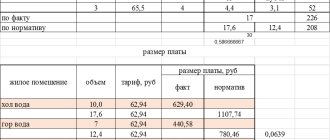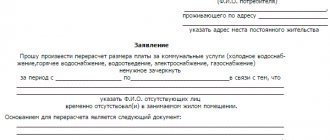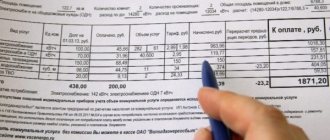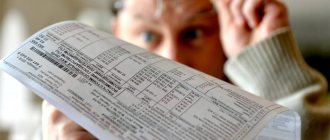Laws regulating relations in the provision of housing and communal services operate with two similar concepts: “social norm” and “standard” for the consumption of utility services. Despite their consonance, they differ functionally. Let's look at these concepts so as not to confuse them when calculating the payment for utilities.
Ministry of Construction of the Russian Federation on the calculation of fees for housing and communal services
62590
When the law applies regulations and social norms
Both of these concepts are from the sphere of calculations of payments for utility services, which are done monthly by utility contractors, including management organizations. Therefore, the concepts of norm and social norm should be distinguished in order to avoid confusion and errors.
The amount of payment for utilities in a residential building with an installed individual metering device is determined based on the readings of such a metering device for the billing period (clause 42 of the Decree of the Government of the Russian Federation dated May 6, 2011 No. 354).
If the meter in the premises is not installed or is out of order, then the volume of resource consumed is determined by calculation methods: the first three months - based on average monthly consumption, then - according to the utility consumption standard (clauses 42, 59, 60 of RF PP No. 354) .
Regardless of the method for determining the volume, the payment for the resource is calculated according to the tariffs established for the population by the executive authority of the constituent entity of the Russian Federation in the field of tariff regulation. At the same time, in the constituent entities of the Russian Federation, where a social norm for the consumption of electrical energy has been established, the amount of payment is calculated according to tariffs established within and above such social norm (clause 38 of the RF PP No. 354).
It is clear from the legislation that the consumption standard and the social norm are applied in different situations: the standard determines the volume of the resource, and the social norm determines the amount of payment depending on the volume. At the same time, the social norm is also applied directly when calculating the payment according to the standard. Let's talk about this in more detail.
New standards for ODN come into effect
153920
Formula for paying for water without a meter and example
There is no uniform tariff for water in Russia. Each subject has its own. This is due to the climatic characteristics of the constituent entities of the Russian Federation, as well as the level of density of people living in it.
Thus, the standard figure is not final when paying. How many cubic meters of water a citizen spends monthly is reflected in the current standard.
Thus, to independently calculate how much to pay for water consumption in an apartment without an IPU, you need to know the current tariff, the number of people registered at the place of residence, the standard and PC.
Let us calculate the consumption of cold water and hot water using the example of Novosibirsk.
Novosibirsk regional tariff HVS = 17.16 rubles. per 1 m3 Cold water standard = 5.193 m3 Increasing factor = 1.5 Number of registered citizens = 2 Thus, 17.16 * 5.193 * 1.5 * 2 = 267.335 rubles.
The owner of the residential premises will have to pay this amount for the consumption of hot water.
Now DHW. The increasing coefficient and the number of registered citizens are the same.
Novosibirsk regional hot water tariff = 100.10 rubles. for 1 m3 DHW standard = 3.687 m3 Thus, 100.10 * 3.687 * 1.5 * 2 = 1107.206 rubles.
The current tariff can be found by calling the city water utility.
If there are no officially registered people in the apartment, then the fee will be charged in this case as well. Then, instead of the number of residents, the value of the number of owners will be substituted.
The solution in this situation is to install water meters. If the water is not used, then you will not have to pay anything.
You can also contact the management company with a request to seal the water pipe. They will do this the next day after your request. Therefore, during the period of absence, no charges will be made for water consumption.
Another reason for the lack of accruals in a residential building that is not equipped with an IPU may be a document confirming military service, sick leave, and the like.
Who sets consumption standards and how?
The standard is the average consumption of utility services per person. Calculation of consumption standards is done in accordance with Decree of the Government of the Russian Federation dated May 23, 2006 No. 306, Decree of the Government of the Russian Federation dated May 6, 2011 No. 354 and regulations adopted at the regional level.
CG consumption standards are approved by the authorities of each constituent entity of the Russian Federation (clause 3 of the Russian Federation Regulations dated May 23, 2006 No. 306). Standards are set for the resource:
- consumed for the maintenance of the common property of an apartment building;
- consumed on the premises of the owners;
- used for maintaining the land plot and outbuildings (clause 10 of the Russian Federation Regulations No. 306).
Standards for the consumption of utilities in the premises of owners are established for three years and during this period are not subject to revision (clause 14 of the RF PP No. 306). The standards established for the maintenance of the common property of owners of apartment buildings may be revised if the degree of energy efficiency of the house has changed, major repairs have been carried out, etc. (clause 16 of the RF PP No. 306).
When determining standards for different utilities at the regional level, different characteristics of the house are taken into account:
- number of storeys of the building, type of heat supply system, etc. - for hot water supply, cold water supply;
- number of rooms in the apartment, area of the house - for energy supply;
- condition of intra-house utility networks - for gas supply;
- the volume of living quarters, the area of all windows, the materials from which the walls and roof are made - for heating.
The wear and tear of in-house engineering systems is taken into account when determining standards for all public services (clause 4 of RF PP No. 306).
For example, standards for public services established in the regions of the Russian Federation:
- Order of the Ministry of Construction, Housing and Public Utilities and Energy of the Republic of Kazakhstan dated July 29, 2016 No. 196,
- Resolution of the State Tariff Regulation Committee of the Saratov Region dated April 20, 2018 No. 14/2,
- Order of the Office for Tariff Regulation and Energy Saving of the Penza Region dated May 19, 2017 No. 31.
According to clauses 42, 60 of the RF PP No. 354, the standard is used to calculate the volume of resource consumed in the following cases:
- in the absence of an IPU and the technical ability to install it;
- if the readings of the established IPU are not transmitted for more than three billing periods in a row;
- in the event of failure of the IPU or in the event of a refusal to allow the contractor to enter the premises to check the meter - after three billing periods from the moment the specified facts are established, using an increasing factor.
What does the electricity tariff consist of and why is it growing?
587863
Standards for the consumption of utilities, approved by the Tariff Department of the Novosibirsk Region for 2021
an increasing factor of 1 is applied to standard charges for utility resources in residential premises where there is no individual meter for the corresponding utility resource 5 . Moreover, according to clause 69 (d(1)) of the Rules, in the payment document the size of the increasing coefficient is indicated separately from the standard volume of the utility service. In its letter dated September 2, 2021 No. 28483-ACh/04, the Ministry of Construction of the Russian Federation explains that the increasing coefficients indicated in the calculation formulas for determining the amount of fees for utility services do not increase the volume of provided utility services . This coefficient does not apply if the consumer submits a report confirming the lack of technical ability to install an individual metering device - starting from the billing period in which such a report was drawn up. The form of the inspection report to determine whether it is technically possible to install metering devices and the procedure for filling it out are approved by Order of the Ministry of Regional Development of Russia No. 627 of December 29, 2011.
Electricity
Electricity consumption standards, kWh per month per person in residential premises of apartment buildings equipped with electric stoves
Number of rooms in residential premises
| Standard, kWh per month per person | |||||
| Number of people living in the residential premises | |||||
| 1 person | 2 people | 3 people | 4 people | 5 or more people | |
| Without taking into account the multiplying factor | |||||
| 1 | 156 | 97 | 75 | 61 | 53 |
| 2 | 184 | 114 | 88 | 72 | 62 |
| 3 | 201 | 125 | 96 | 78 | 68 |
| 4 or more | 213 | 132 | 102 | 83 | 73 |
| Taking into account the increasing factor (1.5) | |||||
| 1 | 234 | 146 | 113 | 92 | 80 |
| 2 | 276 | 171 | 132 | 108 | 93 |
| 3 | 302 | 188 | 144 | 117 | 102 |
| 4 or more | 320 | 198 | 153 | 125 | 110 |
Electricity consumption standards were approved by order of the Tariff Department of the Novosibirsk Region dated August 15, 2012 No. 168-EE. Standards for the consumption of electrical energy for the purpose of maintaining common property in an apartment building kWh per month per 1 m2 of the total area of premises included in the common property
| Category of apartment buildings | Consumption standard | ||
| Apartment buildings not equipped with elevators and electric heating and electric heating installations for hot water supply, equipped with: | |||
| lighting installations inside the MKD building and above the entrances, with the exception of attics, technical floors, technical subfloors and basements, equipped with: | |||
| energy saving lamps | 0,222 | ||
| incandescent lamps | 0,728 | ||
| lighting installations in the attic, technical floor, equipped with: | |||
| energy saving lamps | 0,003 | ||
| incandescent lamps | 0,006 | ||
| lighting installations in the technical underground, basement, equipped with: | |||
| energy saving lamps | 0,016 | ||
| incandescent lamps | 0,054 | ||
| lighting installations illuminating the courtyard areas located on the façade of the apartment building (“cobras”, etc.), equipped with: | |||
| energy saving lamps | 0,045 | ||
| incandescent lamps | 0,151 | ||
| lighting installations located on the territory of the courtyard areas of the MKD (lanterns on poles, etc.), equipped with: | |||
| energy saving lamps | 0,026 | ||
| incandescent lamps | 0,058 | ||
| pumps for hot and (or) cold water supply systems | 0,81 | ||
| heating system pumps | 0,427 | ||
| automatic locking devices | 0,029 | ||
| TV antenna amplifiers for shared use | 0,018 | ||
| automatic fire protection and smoke removal systems | 0,055 | ||
| common house utility metering devices | 0,009 | ||
| Apartment buildings equipped with elevators and not equipped with electric heating and electric heating installations for hot water supply, equipped with: | |||
| lighting fixtures inside the MKD building and above the entrances, with the exception of attics, technical floors, technical subfloors and basements, equipped with: | |||
| energy saving lamps | 0,222 | ||
| incandescent lamps | 0,728 | ||
| lighting fixtures in the attic, technical floor, equipped with: | |||
| energy saving lamps | 0,001 | ||
| incandescent lamps | 0,001 | ||
| lighting fixtures in the technical underground, basement, equipped with: | |||
| energy saving lamps | 0,01 | ||
| incandescent lamps | 0,033 | ||
| lighting fixtures illuminating courtyard areas located on the façade of the apartment building (“cobras”, etc.), equipped with: | |||
| energy saving lamps | 0,018 | ||
| incandescent lamps | 0,06 | ||
| lighting fixtures located in the courtyard areas of the apartment building (lanterns on poles, etc.), equipped with: | |||
| energy saving lamps | 0,018 | ||
| incandescent lamps | 0,04 | ||
| passenger and cargo-passenger elevators and elevator equipment: | |||
| with one elevator at the entrance | 0,973 | ||
| with two elevators at the entrance | 1,814 | ||
| with three or more elevators at the entrance | 2,063 | ||
| pumps for hot and (or) cold water supply systems | 0,707 | ||
| heating system pumps | 0,341 | ||
| automatic locking devices | 0,006 | ||
| TV antenna amplifiers for shared use | 0,003 | ||
| automatic fire protection and smoke removal systems | 0,046 | ||
| common house utility metering devices | 0,009 | ||
| Apartment buildings not equipped with elevators and equipped with electric heating and (or) electric heating installations for hot water supply, during the heating period, equipped with: | |||
| lighting fixtures inside the MKD building and above the entrances, with the exception of attics, technical floors, technical subfloors and basements, equipped with: | |||
| energy saving lamps | 0,222 | ||
| incandescent lamps | 0,728 | ||
| lighting fixtures in the attic, technical floor, equipped with: | |||
| energy saving lamps | 0,003 | ||
| incandescent lamps | 0,006 | ||
| lighting fixtures in the technical underground, basement, equipped with: | |||
| energy saving lamps | 0,016 | ||
| incandescent lamps | 0,054 | ||
| lighting fixtures illuminating courtyard areas located on the façade of the apartment building (“cobras”, etc.), equipped with: | |||
| energy saving lamps | 0,045 | ||
| incandescent lamps | 0,151 | ||
| lighting fixtures located in the courtyard areas of the apartment building (lanterns on poles, etc.), equipped with: | |||
| energy saving lamps | 0,026 | ||
| incandescent lamps | 0,058 | ||
| pumps for hot and (or) cold water supply systems | 0,81 | ||
| heating system pumps | 0,427 | ||
| automatic locking devices | 0,029 | ||
| TV antenna amplifiers for shared use | 0,018 | ||
| automatic fire protection and smoke removal systems | 0,055 | ||
| common house utility metering devices | 0,009 | ||
| Apartment buildings not equipped with elevators and equipped with electric heating and (or) electric heating installations for hot water supply, outside the heating period, equipped | |||
| lighting fixtures inside the MKD building and above the entrances, with the exception of attics, technical floors, technical subfloors and basements, equipped with: | |||
| energy saving lamps | 0,222 | ||
| incandescent lamps | 0,728 | ||
| lighting fixtures in the attic, technical floor, equipped with: | |||
| energy saving lamps | 0,003 | ||
| incandescent lamps | 0,006 | ||
| lighting fixtures in the technical underground, basement, equipped with: | |||
| energy saving lamps | 0,016 | ||
| incandescent lamps | 0,054 | ||
| lighting fixtures illuminating courtyard areas located on the façade of the apartment building (“cobras”, etc.), equipped with: | |||
| energy saving lamps | 0,045 | ||
| incandescent lamps | 0,151 | ||
| lighting fixtures located in the courtyard areas of the apartment building (lanterns on poles, etc.), equipped with: | |||
| energy saving lamps | 0,026 | ||
| incandescent lamps | 0,058 | ||
| pumps for hot and (or) cold water supply systems | 0,81 | ||
| heating system pumps | 0,427 | ||
| automatic locking devices | 0,029 | ||
| TV antenna amplifiers for shared use | 0,018 | ||
| automatic fire protection and smoke removal systems | 0,055 | ||
| common house utility metering devices | 0,009 | ||
Note: When calculating fees for the maintenance of common property in an apartment building (dormitory) belonging to the corresponding category of apartment buildings, the standard consumption of utility services for electricity supply for the purpose of maintaining the common property of an apartment building is determined by summing the standards for the consumption of electrical energy established for this category of apartment buildings by the corresponding actually installed equipment and devices consuming electrical energy that are part of the common property in an apartment building. When determining the standards specified in this appendix, the areas of premises that are not parts of apartments and intended to serve more than one room in a given building are taken into account, including inter-apartment landings, stairs, elevators, elevator and other shafts, corridors, technical floors, attics , basements. The utility consumption standard for electricity supply, which takes into account pumping equipment for cold and hot water supply, heating and control equipment for pumps installed directly in an apartment building (or a group of houses), is applied if the electrical equipment is not listed on the balance sheet of the resource supplying organization. Standards for the consumption of electrical energy for the purpose of maintaining common property were approved by order of the Tariff Department of the Novosibirsk Region dated May 22, 2021 No. 216-EE.
Water supply and sanitation
Standards for the consumption of utilities for cold and hot water supply and sanitation, cubic meters. m for 1 person per month
| Degree of improvement of residential premises | Hot water supply | Cold water supply | Water disposal |
| Residential premises (including apartment-type dormitories) with cold and hot water supply, sewerage, equipped with bathtubs 1500-1700 mm long, showers, sinks, kitchen sinks and toilets | Without taking into account the multiplying factor | ||
| 3,687 | 5,193 | 8,88 | |
| Taking into account the increasing factor (1.5) | |||
| 5,5305 | 7,7895 | 13,32 | |
| Residential premises (including apartment-type dormitories) with cold and hot water supply, sewerage, equipped with 1200 mm long sitz baths, showers, sinks, kitchen sinks and toilets | Without taking into account the multiplying factor | ||
| 3,627 | 5,145 | 8,772 | |
| Taking into account the increasing factor (1.5) | |||
| 5,4405 | 7,7175 | 13,158 | |
| Residential premises with cold and hot water supply, sewerage, equipped with showers, sinks, kitchen sinks and toilets | Without taking into account the multiplying factor | ||
| 2,978 | 4,619 | 7,597 | |
| Taking into account the increasing factor (1.5) | |||
| 4,467 | 6,9285 | 11,3955 | |
| Dormitories with cold and hot water supply, sewerage, equipped with showers, sinks, kitchen sinks and toilets | Without taking into account the multiplying factor | ||
| 2,442 | 4,182 | 6,625 | |
| Taking into account the increasing factor (1.5) | |||
| 3,663 | 6,273 | 9,9375 | |
Standards for water supply and sanitation were approved by order of the Tariff Department of the Novosibirsk Region dated August 16, 2012 No. 170-B (Appendices 1.1, 2.1).
Standards for the consumption of cold water, hot water and wastewater disposal for the purpose of maintaining common property in an apartment building, applied from June 1, 2021, cubic meters. meter per month per 1 m2 of total area of premises included in the common property
| Category of apartment buildings | Cold water | Hot water | Wastewater |
| Apartment buildings with centralized cold and hot water supply and sanitation | 0,023 | 0,021 | 0,044 |
| Apartment buildings with centralized cold water supply, water heaters, sanitation | 0,023 | x | 0,023 |
| Apartment buildings without water heaters with centralized cold water supply and sanitation, equipped with sinks, sinks and toilets | 0,023 | x | 0,023 |
| Apartment buildings with centralized cold water supply without centralized drainage | 0,023 | x | x |
Note. The total area of the premises included in the common property in an apartment building (dormitory) is determined as the total area of the following premises that are not parts of the apartments of the apartment building (dormitory) and are intended to serve more than one room in the apartment building (dormitory), according to the information specified in the passport of an apartment building: the area of inter-apartment landings, stairs, corridors, vestibules, halls, lobbies, strollers, security (concierge) premises in this apartment building (dormitory), which do not belong to individual owners. Standards for water and wastewater consumption for the purpose of maintaining common property were approved by order of the Tariff Department of the Novosibirsk Region dated May 22, 2021 No. 215-B.
Heating
Standards for the consumption of utilities for heating, calculated for a heating period lasting 9 calendar months, Gcal per 1 m2 of the total area of residential and non-residential premises in an apartment building
From July 1, 2021, the formula determining the procedure for heating charges for houses not equipped with heat metering devices, by Decree of the Government of the Russian Federation No. 603 dated June 29, 2016, introduced a coefficient for the frequency of payment by consumers for utility payments for heating. It is determined by dividing the number of full months of the heating period in a year by the number of calendar months (clause 2 of Appendix 2 of Government Decree No. 354 of the Russian Federation). That is, if regional authorities calculated the standards for 9 months, but at the same time decided that payment for heating utilities is carried out evenly throughout the calendar year, then this ratio will be equal to 9/12.
| Number of storeys | Houses built before 1999 (inclusive) | |
| Without taking into account coefficients | Taking into account the periodicity coefficient (9/12) | |
| 1, 3, 4 | 0,025 | 0,01875 |
| 2 | 0,023 | 0,01725 |
| 5, 6, 7, 8, 9 | 0,021 | 0,01575 |
| 10 or more | 0,02 | 0,015 |
| Number of storeys | Houses built after 1999 | |
| 1 | 0,02 | 0,015 |
| 2, 6, 7 | 0,018 | 0,0135 |
| 3, 4, 5, 8, 9 | 0,019 | 0,01425 |
| 10 or more | 0,016 | 0,012 |
Standards for the consumption of utilities for heating are determined by order of the Tariff Department of the Novosibirsk Region dated June 15, 2016 No. 85.
Municipal solid waste
The standard amount of waste per 1 resident per year was approved by Order of the Tariff Department of the Novosibirsk Region No. 342-ZhKH dated October 20, 2021 and is 2.38 m3/year (or 392.95 kg).
When does a social norm apply?
If the standard is established and applies to all public services, then the social standard was introduced in Russia only for electricity consumption and not in all regions. Government Decree No. 354 dated 05/06/2011 and Order No. 20-e/2 of the Federal Tariff Service of the Russian Federation dated 08/06/2004 establish the ability of constituent entities of the Russian Federation to set tariffs for electricity supplied to the population within the social norm and above this norm. This method of calculating the volume of electrical energy consumption should help consumers use the resource more rationally.
A social norm is the amount of resource established for one person and used to determine the tariff when calculating fees for utility services. The amount of electricity within the social norm is calculated at a lower tariff compared to kWh consumed in excess of the norm.
The application of social norms for electricity consumption became possible after the entry into force of Decree of the Government of the Russian Federation dated July 22, 2013 No. 614. The normative act regulated the procedure for establishing and applying social norms. Decree of the Government of the Russian Federation No. 614 established the obligation of utility contractors to keep separate records of the volumes of electrical energy supplied to consumers within and in excess of the social norm (clause 47 of Section III of the RF Government No. 614).
The norm for each region is determined by the authorities of the constituent entities of the Russian Federation, which are responsible for regulating tariffs (clause 3 of section II of the RF PP No. 614). If a decision has been made in the region to introduce a social norm for electricity consumption, then when setting tariffs for energy supply services, tariffs for the population and categories equivalent to it, two tariffs are introduced for each group:
- low – to calculate the fee per kWh within the social norm;
- high – to calculate fees for the amount of electricity consumed in excess of the norm.
In each region where a decision is made to apply social norms, their size depends on climatic conditions and the length of daylight hours. Regardless of the subject of the Russian Federation, established social norms are different for premises with different characteristics (Appendices 5.1, 5.2 to RF PP No. 614).
The social norm depends on:
- location of the premises in a city or rural area;
- the presence of a stationary electric stove;
- DHW and heat supply systems: are electric heaters or other installations used for this;
- condition of the house: accident rate, degree of wear and tear;
- heating season.
Moreover, the more people are registered in a residential premises, the higher the social norm for electricity consumption in such premises will be. For example:
The limits of the social norm are used in determining the payment for electricity both in the presence of readings from individual metering devices and in calculation methods: according to the average and according to the standard (clause 32 of the RF PP No. 354, clause 33 of section III of the RF PP No. 614). It is also used when calculating payments for resources consumed for the maintenance of common property of apartment buildings (clause 32, section III of RF PP No. 614).
If, due to lack of technical capabilities, an electric power supply unit is not installed in the premises, the payment for the entire volume of the resource, determined based on the standard, will be calculated at a tariff within the social norm (low).
In the absence of IPU (loss, failure), the volume is calculated in accordance with clauses 59, 60 of the RF PP No. 354 using the established social norm for two calculation periods. Then the social norm is applied with a coefficient that reduces it, of which the CG provider must notify the consumer.
If within two months the consumer has not established an IPU, then in the first six months a coefficient of 0.9 is applied to the value of the social norm. Then, every 6 months, the coefficient for reducing the social norm is reduced by 0.1 to the limit value of 0.7 (clause 33 of section III of the RF PP No. 614).
To date, a social norm for calculating payments for electrical energy consumed by the population has been introduced only in a few constituent entities of the Russian Federation. For example, in the Rostov, Oryol, Vladimir regions, in the Trans-Baikal Territory.
Post-release of the webinar “New procedure for calculating the amount of fees for CG”
29400
Increasing coefficients
Since 2011, the increasing coefficient (IC) for water without a meter has been used in relation to owners who, for various reasons, have not installed water meters. In 2021 it is 1.5.
The increased coefficient is introduced to encourage citizens to install water meters. It is beneficial for the municipality for the owners to install individual metering devices, because one person can be registered in the apartments, but in fact there are more people living there. And actual water consumption increases several times.
Thus, it is necessary to multiply the current water consumption standard per person, the number of registered people, the tariff and the PC. The figure turns out to be large, and it encourages people to install water meters.
The coefficient is not entered when it is technically impossible to install an individual meter. For example, due to dilapidated pipes.
They plan to increase the increasing coefficient to 1.6. This suggests that the state will continue to raise this figure. Therefore, for owners of residential premises who have not yet installed an IPU and have the technical ability to do so, it is more profitable to buy a water meter.
Hot water consumption per person without a meter
It has been determined that a person spends more cold water than hot water. Therefore, the monthly standard for it is slightly lower and amounts to 4.745 cubic meters . At the same time, calculations are made separately for water entering the heating system.
The standard includes only actual consumption figures for each person and it is believed that no more than 140 liters of hot water are consumed daily for all his needs. The same rule applies here as with cold water, when utility companies can increase the standard no more than twice. And you need to pay according to the standard for each citizen registered in the living space.
The formula for calculating the fee for hot water is similar to the calculation for cold water using the cost of 1 cubic meter of hot water according to the regional tariff.
Note that by dividing the consumption rate of hot and cold water by 30 days in a month, we get quite serious numbers. This more than covers all possible expenses, so meters will help significantly save your family’s water costs. This is especially true for those who have a fairly large family living and registered in their apartment.
Standards and tariffs for water consumption by city for 2021
Current water tariffs and standards vary for each subject of the Russian Federation. They are established by local authorities based on regional characteristics, population density and other reasons.
The table displays the values of subject standards and tariffs for water without a meter in 2021. They are relevant for all apartments that have plumbing equipment and are connected to the utility network.
It is also worth considering that within the city the indicators may vary slightly. It all depends on the company that provides the resource. Consequently, the cost of water without a meter will vary.
| City | Hot water supply | Cold water supply | |||
| Standard | Rate | Standard | Rate | ||
| Moscow | 4,745 | 198,19 | 6,935 | 40,48 | |
| Saint Petersburg | 3,48 | 105,92 | 8,48 | 31,58 | |
| Permian | 2,8 | 162,31 | 5,72 | 33,03 | |
| Samara | 3,24 | thermal energy | 1682,40 | 8,13 | 31,60 |
| coolant | 37,55 | ||||
| Ufa | 3,24 | thermal energy | 2134,16 | 7,55 | 25,68 |
| coolant | 25,68 | ||||
| Omsk | 3,4 | thermal energy | 1397,84 | 6,7 | 17,08 |
| coolant | 17,93 | ||||
| Chelyabinsk | 2,56 | 60,48 | 6,06 | 25,14 | |
| Krasnodar | 2,65 | thermal energy | 1621,58 | 6,59 | 38,71 |
| coolant | 25,33 | ||||
| Kazan | 3,57 | thermal energy | 1541,90 | 8,96 | 20,59 |
| coolant | 20,59 | ||||
| Rostov-on-Don | 3,45 | thermal energy | 2205,66 | 6,5 | 20,59 |
| coolant | 49,79 | ||||
| Nizhny Novgorod | 3,77 | 88,84 | 6,74 | 19,04 | |
| Saratov | 3,18 | thermal energy | 1909,72 | 7,55 | 25,10 |
| coolant | 25,10 | ||||
| Novosibirsk | 3,68 | 108,19 | 6,47 | 18,56 | |
| Penza | 3,20 | thermal energy | 1780,64 | 6,67 | 39,86 |
| coolant | 25,10 | ||||
| Smolensk | 3,92 | 151,83 | 6,60 | 25,19 | |
| Kaluga | 3,20 | thermal energy | 2104,62 | 7,56 | 28,25 |
| coolant | 28,25 | ||||
| Belgorod | 3,17 | 110,04 | 7,45 | 25 | |
Cold water consumption per person without a meter
It was calculated that on average a person can consume 6.935 cubic meters of cold water per month. What made up this figure? We regularly spend resources on daily needs, without which the concept of a comfortable life is impossible.
To calculate water consumption in general, both hot and cold, we took the average statistical indicators that a person needs daily for the following purposes:
- showering daily – up to 30 liters;
- washing, shaving, etc., which constitutes our daily needs, is 200 liters per week;
- the water that is collected in the toilet tank is approximately 60 liters per day;
- bathing – 200 liters per week;
- other expenses associated with laundry, cleaning, washing dishes.
There are also losses and other costs of water that may affect the entire residential building. This includes general house needs for cleaning common areas, costs associated with unauthorized connections, leaks in the water supply system of the house and many other factors.
As a result, a decent amount comes in, from which an approximate amount of cold water was extracted. It was adopted as the consumption standard per person per month, if the housing does not have an individual meter.
This is a fairly large amount, which is difficult to cover without even saving water. But utility services have the right to increase it if necessary to cover their costs. At the same time, the upper limit is strictly limited - it should not be more than two standard sizes.









